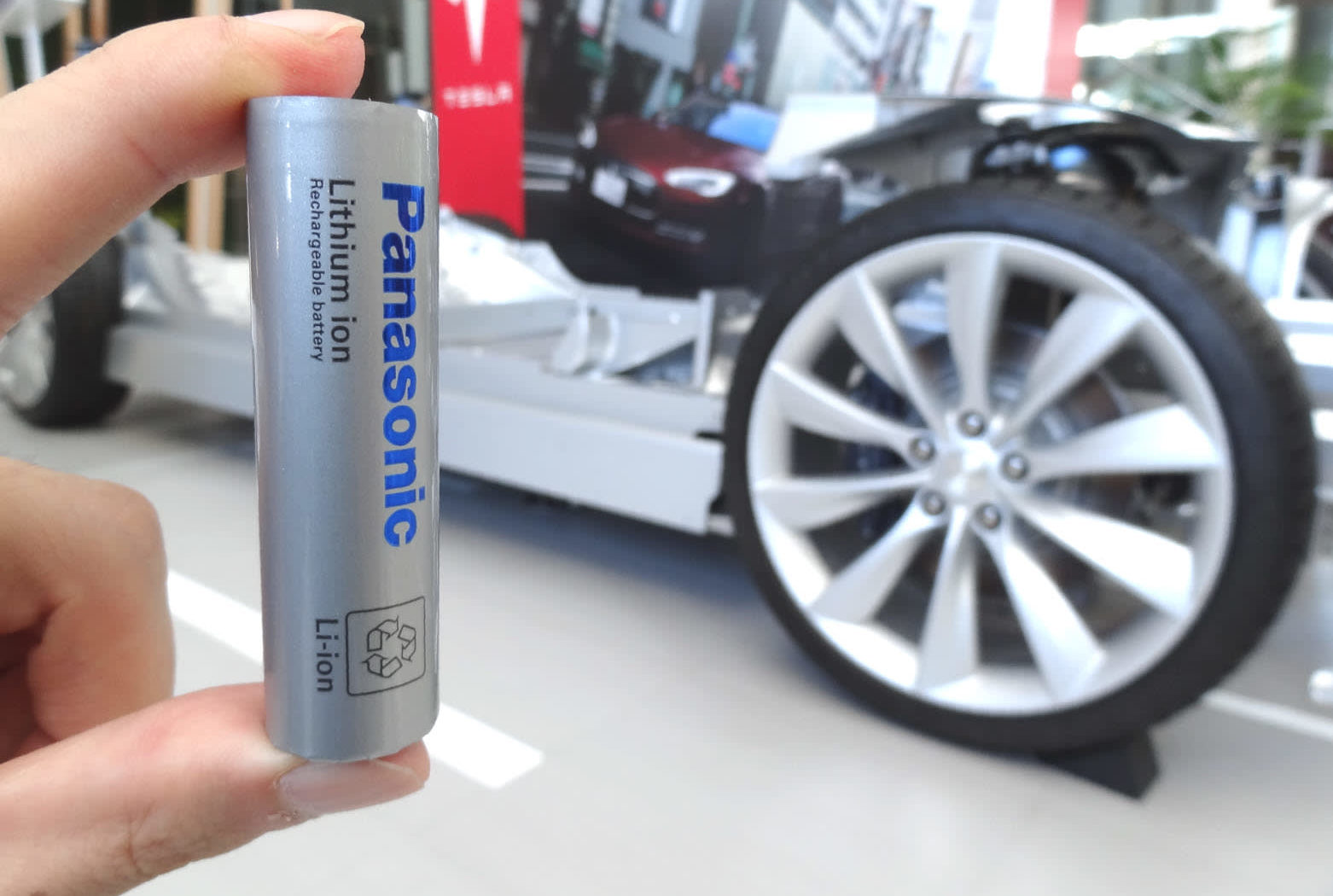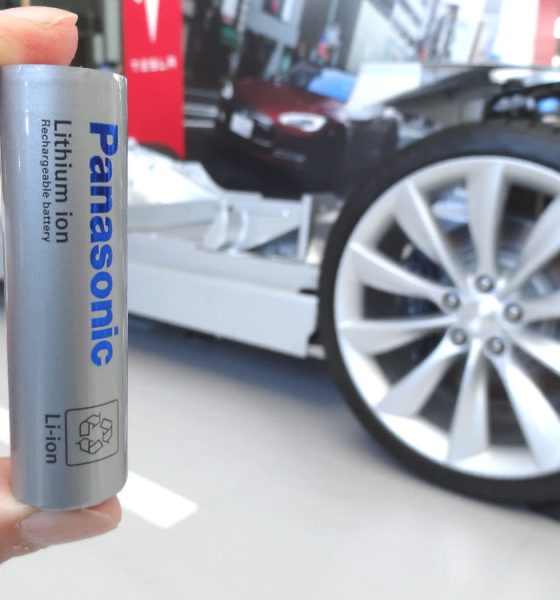

News
Tesla battery supplier Panasonic wants cobalt-free cells in 2-3 years
Tesla battery supplier Panasonic wants to do away with cobalt in its electric vehicle battery cells within two to three years, which would decrease cost and increase the company’s ability to keep up with the automaker’s lofty plans for a global expansion.
Over the past few years, Tesla has really dialed in a focus on electric vehicle battery production and sourcing materials for its cells in mass amounts. The automaker has also focused on battery longevity, which cobalt assists in as it secures each battery’s stability and life cycle. However, cobalt is an extremely controversial mineral. It is usually mined in the Republic of Congo, where child labor is used, and many companies have attempted to get rid of cobalt in their cells altogether. Panasonic is one of those companies, Nikkei Asia reported.
Shawn Watanabe, Head of Energy Technology and Manufacturing at Panasonic of Japan, detailed his company’s plan to out cobalt from its cells during a virtual session for the Consumer Electronics Show, which is the world’s largest consumer electronics and tech expo, on Wednesday. “Two or three years from now, we will be able to introduce a cobalt-free high energy-density cell,” he said.
Getting rid of cobalt in cells would not only reduce the cost of cells, but the price of electric vehicles would decrease as well. The battery pack of an EV is the most expensive part of the car and accounts for between 30 and 40% of the vehicle. Panasonic, who has been in partnership with Tesla since 2014 and recently signed a new battery supply deal with the Elon Musk-headed company, assists in the operation of the Tesla Gigafactory in Sparks, Nevada.
Ultimately, the cost of batteries is what really drives the price of EVs up. Tesla has worked tirelessly to figure out EV cell supply constraints and has started manufacturing its own 4680 cell in-house. The way to reduce costs is to mass-produce cells, which requires sizeable material contracts, and Tesla is focusing in on nickel for the future, and not cobalt.
ALSO READ:
Panasonic President shares insights on Tesla’s 4680 battery cell production plans
“I’d just like to re-emphasize, any mining companies out there, please mine more nickel,” Musk said during the company’s Q2 2020 Earnings Call. “Tesla will give you a giant contract for a long period of time if you mine nickel efficiently and in an environmentally sensitive way.”
Panasonic is taking the same strategy, according to Celin Mikolajczak, VP of Battery Technology for Panasonic North America. “Reducing cobalt makes it harder for us to manufacture, but ultimately does reduce the negative environmental impacts of batteries and reduce the cost.”
Panasonic is also attempting to cut costs by recycling its batteries and materials. It recently paired up with J.B. Straubel, a Tesla founder who started Redwood Materials. “The materials we use are very valuable. We’ve always recycled. It’s a steady stream of raw material, and that could become an appreciable part of our supply chain,” Mikolajczak said.

News
Tesla FSD fleet is nearing 7 billion total miles, including 2.5 billion city miles
As can be seen on Tesla’s official FSD webpage, vehicles equipped with the system have now navigated over 6.99 billion miles.

Tesla’s Full Self-Driving (Supervised) fleet is closing in on almost 7 billion total miles driven, as per data posted by the company on its official FSD webpage.
These figures hint at the massive scale of data fueling Tesla’s rapid FSD improvements, which have been quite notable as of late.
FSD mileage milestones
As can be seen on Tesla’s official FSD webpage, vehicles equipped with the system have now navigated over 6.99 billion miles. Tesla owner and avid FSD tester Whole Mars Catalog also shared a screenshot indicating that from the nearly 7 billion miles traveled by the FSD fleet, more than 2.5 billion miles were driven inside cities.
City miles are particularly valuable for complex urban scenarios like unprotected turns, pedestrian interactions, and traffic lights. This is also the difference-maker for FSD, as only complex solutions, such as Waymo’s self-driving taxis, operate similarly on inner-city streets. And even then, incidents such as the San Francisco blackouts have proven challenging for sensor-rich vehicles like Waymos.
Tesla’s data edge
Tesla has a number of advantages in the autonomous vehicle sector, one of which is the size of its fleet and the number of vehicles training FSD on real-world roads. Tesla’s nearly 7 billion FSD miles then allow the company to roll out updates that make its vehicles behave like they are being driven by experienced drivers, even if they are operating on their own.
So notable are Tesla’s improvements to FSD that NVIDIA Director of Robotics Jim Fan, after experiencing FSD v14, noted that the system is the first AI that passes what he described as a “Physical Turing Test.”
“Despite knowing exactly how robot learning works, I still find it magical watching the steering wheel turn by itself. First it feels surreal, next it becomes routine. Then, like the smartphone, taking it away actively hurts. This is how humanity gets rewired and glued to god-like technologies,” Fan wrote in a post on X.
News
Tesla starts showing how FSD will change lives in Europe
Local officials tested the system on narrow country roads and were impressed by FSD’s smooth, human-like driving, with some calling the service a game-changer for everyday life in areas that are far from urban centers.

Tesla has launched Europe’s first public shuttle service using Full Self-Driving (Supervised) in the rural Eifelkreis Bitburg-Prüm region of Germany, demonstrating how the technology can restore independence and mobility for people who struggle with limited transport options.
Local officials tested the system on narrow country roads and were impressed by FSD’s smooth, human-like driving, with some calling the service a game-changer for everyday life in areas that are far from urban centers.
Officials see real impact on rural residents
Arzfeld Mayor Johannes Kuhl and District Administrator Andreas Kruppert personally tested the Tesla shuttle service. This allowed them to see just how well FSD navigated winding lanes and rural roads confidently. Kruppert said, “Autonomous driving sounds like science fiction to many, but we simply see here that it works totally well in rural regions too.” Kuhl, for his part, also noted that FSD “feels like a very experienced driver.”
The pilot complements the area’s “Citizen Bus” program, which provides on-demand rides for elderly residents who can no longer drive themselves. Tesla Europe shared a video of a demonstration of the service, highlighting how FSD gives people their freedom back, even in places where public transport is not as prevalent.
What the Ministry for Economic Affairs and Transport says
Rhineland-Palatinate’s Minister Daniela Schmitt supported the project, praising the collaboration that made this “first of its kind in Europe” possible. As per the ministry, the rural rollout for the service shows FSD’s potential beyond major cities, and it delivers tangible benefits like grocery runs, doctor visits, and social connections for isolated residents.
“Reliable and flexible mobility is especially vital in rural areas. With the launch of a shuttle service using self-driving vehicles (FSD supervised) by Tesla in the Eifelkreis Bitburg-Prüm, an innovative pilot project is now getting underway that complements local community bus services. It is the first project of its kind in Europe.
“The result is a real gain for rural mobility: greater accessibility, more flexibility and tangible benefits for everyday life. A strong signal for innovation, cooperation and future-oriented mobility beyond urban centers,” the ministry wrote in a LinkedIn post.
News
Tesla China quietly posts Robotaxi-related job listing
Tesla China is currently seeking a Low Voltage Electrical Engineer to work on circuit board design for the company’s autonomous vehicles.

Tesla has posted a new job listing in Shanghai explicitly tied to its Robotaxi program, fueling speculation that the company is preparing to launch its dedicated autonomous ride-hailing service in China.
As noted in the listing, Tesla China is currently seeking a Low Voltage Electrical Engineer to work on circuit board design for the company’s autonomous vehicles.
Robotaxi-specific role
The listing, which was shared on social media platform X by industry watcher @tslaming, suggested that Tesla China is looking to fill the role urgently. The job listing itself specifically mentions that the person hired for the role will be working on the Low Voltage Hardware team, which would design the circuit boards that would serve as the nervous system of the Robotaxi.
Key tasks for the role, as indicated in the job listing, include collaboration with PCB layout, firmware, mechanical, program management, and validation teams, among other responsibilities. The role is based in Shanghai.
China Robotaxi launch
China represents a massive potential market for robotaxis, with its dense urban centers and supportive policies in select cities. Tesla has limited permission to roll out FSD in the country, though despite this, its vehicles have been hailed as among the best in the market when it comes to autonomous features. So far, at least, it appears that China supports Tesla’s FSD and Robotaxi rollout.
This was hinted at in November, when Tesla brought the Cybercab to the 8th China International Import Expo (CIIE) in Shanghai, marking the first time that the autonomous two-seater was brought to the Asia-Pacific region. The vehicle, despite not having a release date in China, received a significant amount of interest among the event’s attendees.








